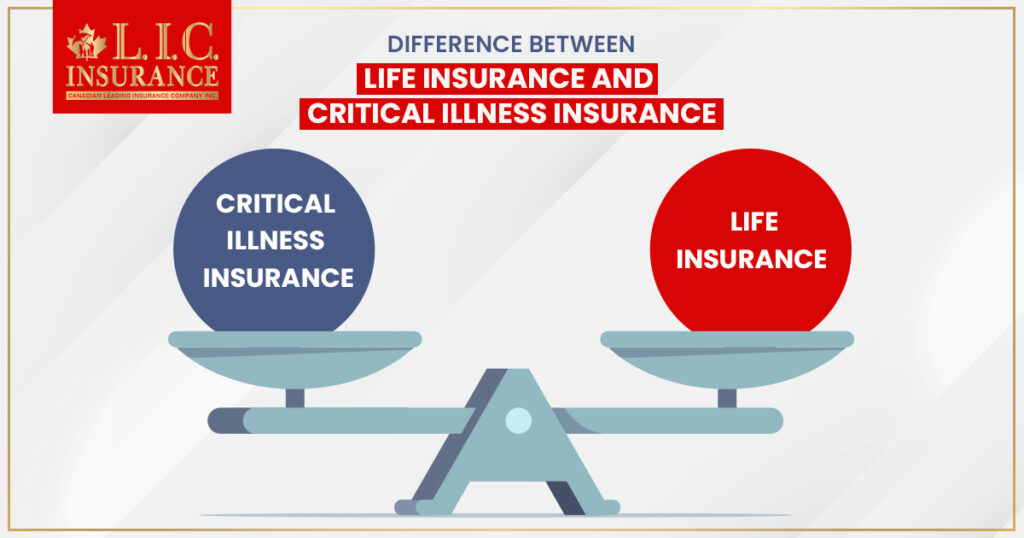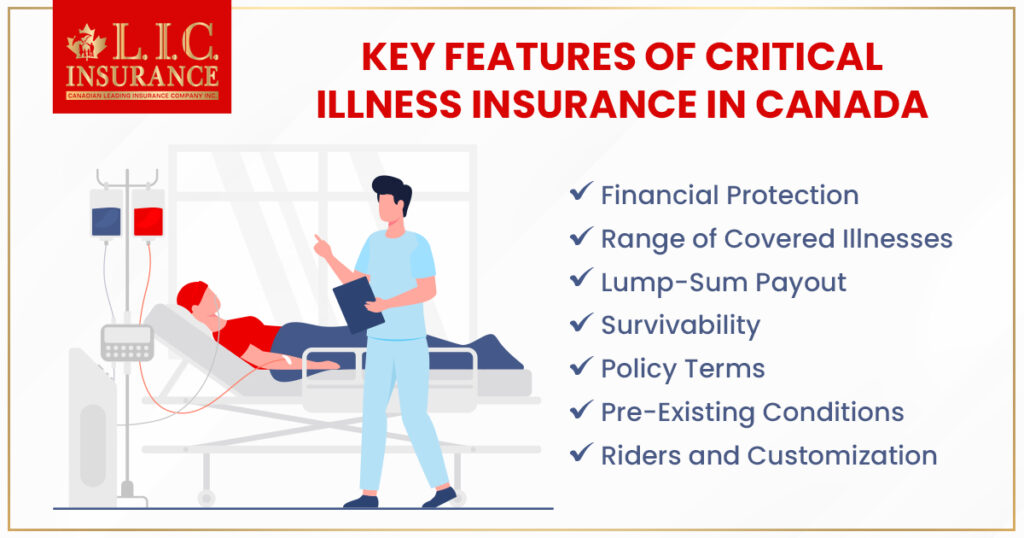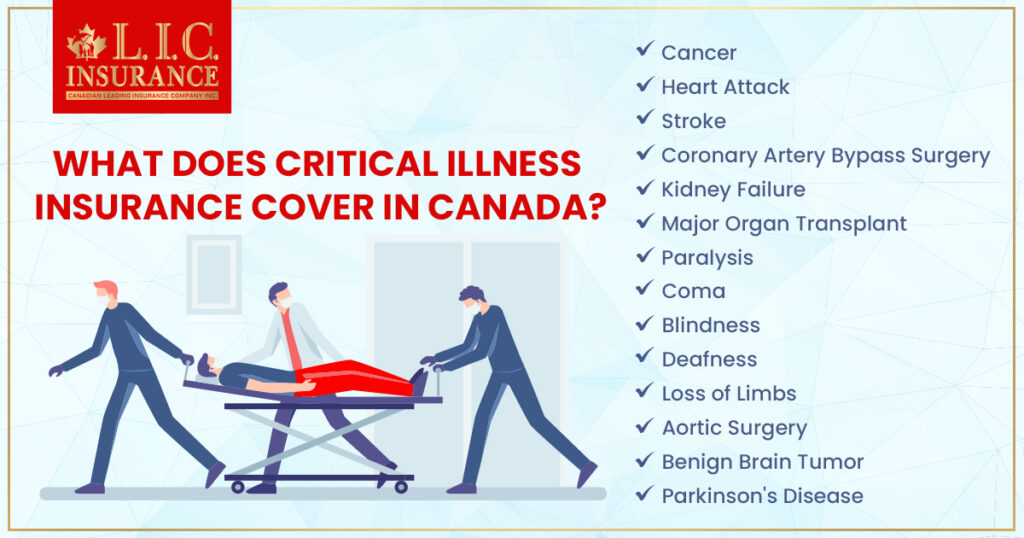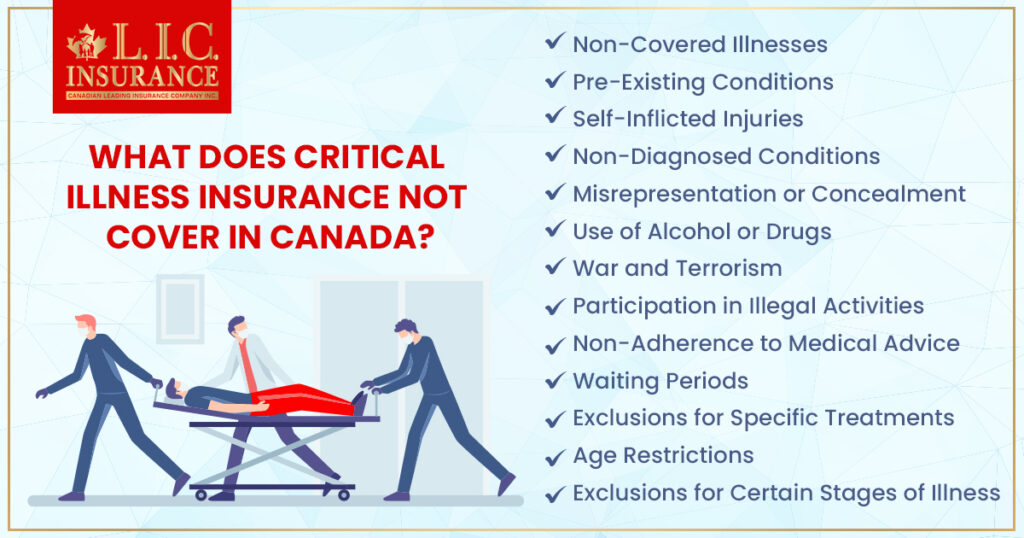
October 20, 2023, Pushpinder Puri, 6 Mins
Critical Illness Insurance is a vital component of financial planning in Canada, providing individuals and families with crucial protection against the financial hardships that often accompany a serious illness diagnosis. This insurance product offers financial security by providing a lump-sum payout upon the diagnosis of a covered critical illness or medical condition. In Canada, where access to healthcare is mainly universal, Critical Illness Insurance fills the gap by addressing the financial aspects of dealing with a severe health crisis.
Key Features of Critical Illness Insurance in Canada
Difference between Life Insurance and Critical Illness Insurance
What does Critical Illness Insurance cover in Canada?

Hence, Critical Illness Insurance plays a vital role in the financial well-being of Canadians facing severe health challenges. It offers peace of mind by providing financial support precisely when it’s needed most, allowing policyholders and their families to focus on recovery rather than worrying about the associated financial burdens. As with any insurance product, it’s crucial to carefully read and understand policy terms and consult with professionals to make informed decisions about Critical Illness Insurance in Canada. Consult Canadian LIC to get the best solutions as per your situation.
Read More – What is Critical Illness Insurance here
Life insurance and Critical Illness Insurance are two distinct types of insurance products available in Canada, each serving a different purpose. The table given below highlights the key differences between Critical Illness Insurance and life insurance in Canada, including their purposes, triggering events, use of funds, premiums, taxation, and other important aspects.
| Aspect | Critical Illness Insurance | Life Insurance |
|---|---|---|
| Purpose | Provides a lump-sum payout upon the diagnosis of a covered critical illness or medical condition, providing financial support during recovery. | Provides a payout to beneficiaries upon the policyholder’s death, offering financial protection to loved ones. |
| Triggering Event | Payout triggered by the diagnosis of a covered critical illness during the policy term. | Payout is triggered by the policyholder’s death, as long as the policy is in force and premiums are up to date. |
| Use of Funds | The lump-sum payout can be used at the policyholder’s discretion, whether for medical expenses, debt repayment, or daily living expenses during illness. | Beneficiaries use the payout to cover immediate expenses, debts, and ongoing living expenses after the policyholder’s death. |
| Duration | Policies can be term-based or shorter-term, aligning with potential high-risk years for critical illnesses. | Term-based or permanent policies can last a lifetime, providing long-term protection. |
| Premiums | Premiums are generally higher due to the lower probability of a critical illness diagnosis during the policy term. | Premiums are typically lower because the likelihood of a death benefit payout is higher. |
| Beneficiaries | The policyholder receives the payout upon the diagnosis of a critical illness. | Beneficiaries receive the payout upon the policyholder’s death. |
| Customization | Riders can be added to enhance coverage, such as disability riders or return of premium riders. | Riders and endorsements are available to customize coverage, such as adding critical illness or accidental death riders. |
| Taxation | Payouts are typically tax-free, providing financial relief during a critical illness. | Payouts are generally tax-free for beneficiaries in Canada. |
| Pre-Existing Conditions | Coverage for pre-existing conditions varies by policy and insurer. Some may be excluded from coverage. | Policies may be issued without regard to pre-existing conditions, but coverage and premiums can be affected. |
| Waiting Period | Most policies have no waiting period, and coverage becomes effective immediately upon approval. | Coverage typically begins immediately upon policy approval or at the start of the chosen term. |
| Additional Benefits | May offer additional benefits, such as rehabilitation benefits or coverage for specific conditions unique to the policy. | May include riders for additional coverage, such as accidental death and dismemberment or living benefits. |
| Survival of Policyholder | Provides financial support to the policyholder while alive and dealing with a critical illness diagnosis. | Provides financial protection to beneficiaries after the policyholder’s death. |
| Common Covered Events | Covered conditions may include cancer, heart attack, stroke, organ transplant, and others. | Typically covers a broad range of causes of death, including illness, accidents, and natural causes. |
Purpose:
Triggering Events:
Use of Funds:
Duration:
Premiums:
It’s important to carefully assess your financial needs and priorities when deciding which insurance product to purchase. Some individuals may choose to have both life insurance and Critical Illness Insurance to provide comprehensive protection for themselves and their loved ones in Canada. Consulting with a qualified insurance advisor like Canadian LIC can help you determine the most suitable coverage for your specific circumstances.
Read More – Critical Illness Insurance here

Critical Illness Insurance in Canada typically covers a specific list of critical illnesses and medical conditions. The exact coverage can vary depending on the insurance provider and policy, so it’s essential to review the policy terms and definitions carefully. However, common critical illnesses and conditions covered by Critical Illness Insurance in Canada often include:
It’s important to note that the specific illnesses and conditions covered can vary among insurance providers and policy options. Additionally, policies may have varying definitions and criteria for determining the severity of a covered condition, which can affect the payout amount.
Before purchasing Critical Illness Insurance in Canada, individuals should carefully read and understand their policy’s terms and definitions. Contact Canadian LIC- a licensed insurance advisor can ensure that you select a policy that aligns with your specific health needs and financial goals.

Critical Illness Insurance policies in Canada typically come with specific exclusions and limitations as well. These exclusions can vary depending on the insurance provider and the specific policy you choose. While the exact exclusions may differ, there are some common elements and types of situations that Critical Illness Insurance typically does not cover:
Understanding the exclusions and limitations is essential to avoid surprises when making a claim. If you have questions or need clarification about the coverage provided, consider consulting with Canadian LIC, who can help you choose a policy that suits your specific needs and circumstances.
Life insurance is a financial product that provides a payout to your beneficiaries when you pass away. In Canada, when you purchase a life insurance policy, you pay regular premiums, and in return, your chosen beneficiaries receive a lump-sum payment (the death benefit) upon your death.
Critical Illness Insurance in Canada provides a lump-sum payout to you (the policyholder) if you are diagnosed with a specified critical illness during the policy term. This differs from life insurance, which pays out to your beneficiaries upon death.
Common critical illnesses covered by Critical Illness Insurance in Canada may include cancer, heart attack, stroke, organ transplant, and other specific medical conditions. The list of covered illnesses can vary among insurance providers, so reviewing the policy details is essential.
Yes, many individuals choose to have both life insurance and Critical Illness Insurance to provide comprehensive protection. Life insurance helps your loved ones financially after your death, while Critical Illness Insurance provides support if you are diagnosed with a critical illness and survive.
Premiums for life insurance are generally lower than those for Critical Illness Insurance in Canada because the likelihood of a payout is higher for life insurance (everyone eventually passes away). Critical Illness Insurance premiums are typically higher due to the lower probability of a critical illness diagnosis during the policy term.
Some insurance providers in Canada offer critical illness riders that can be added to a life insurance policy for an additional cost. This allows you to have both types of coverage under one policy, simplifying your insurance needs.
The appropriate coverage amount depends on your individual circumstances, including your financial responsibilities, goals, and budget. It’s advisable to consult with Canadian LIC, an expert insurance advisor, as they can help you assess your needs and recommend suitable coverage amounts.
In most cases, life insurance payouts are not taxable in Canada. However, the tax treatment of Critical Illness Insurance payouts can vary depending on several factors, including how the policy is structured. It’s advisable to consult with a tax professional to understand the tax implications fully.
It is possible to obtain life insurance or Critical Illness Insurance in Canada if you have pre-existing health conditions, but the availability and terms of coverage may vary among insurance providers. It’s essential to disclose all relevant information when applying for insurance, and some policies may come with higher premiums or exclusions related to pre-existing conditions.
To choose the right insurance provider and policy in Canada, consider working with Canadian LIC, a licensed insurance advisor who can help you assess your needs, compare options, and find a policy that aligns with your financial goals and circumstances.
Always make sure to read and understand the policy terms, conditions, and exclusions before purchasing any insurance product in Canada.
The above information is only meant to be informative. It comes from Canadian LIC's own opinions, which can change at any time. This material is not meant to be financial or legal advice, and it should not be interpreted as such. If someone decides to act on the information on this page, Canadian LIC is not responsible for what happens. Every attempt is made to provide accurate and up-to-date information on Canadian LIC. Some of the terms, conditions, limitations, exclusions, termination, and other parts of the policies mentioned above may not be included, which may be important to the policy choice. For full details, please refer to the actual policy documents. If there is any disagreement, the language in the actual policy documents will be used. All rights reserved.
Please let us know if there is anything that should be updated, removed, or corrected from this article. Send an email to [email protected] or [email protected]